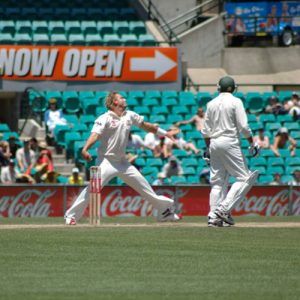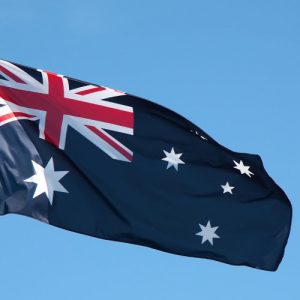 [Updated 31 January 2022, with videos.]
[Updated 31 January 2022, with videos.]
Under the Southern Cross I stand,
A sprig of wattle in my hand,
A native of my native land,
Australia, you f***ing beauty!
This poem is one used by the Australian cricket team as their “victory song”; to be recited by the team following a win, usually chanted in the confines of their dressing room or at an after-match celebration. The last line of the “official version” is given as “Australia, you little beauty”.[1]
The tradition of the Australian cricket team chanting “Under the Southern Cross I Stand” began in 1974, when Rod Marsh gave a rendition of the poem after Australia had beaten England at the Gabba (the Brisbane Cricket Ground, situated in Woolloongabba). The unofficial role of “songmaster” has been handed down through the ranks of Australian cricketers; from Rod Marsh the role was passed on to Allan Border, then David Boon, Ian Healy, Ricky Ponting (also known as “Punter”), Justin Langer, Mike Hussey, and Nathan Lyon. Upon retirement from the team, or becoming team captain, each custodian of the verse appoints his successor.[2]
Rod Marsh (also known as “Bacchus”, a reference to the town of Bacchus Marsh) had learnt the verse from the then captain of the Australian cricket team, Ian Chappell, who had heard it in 1963 from another Australian cricketer, Raymond Patrick Hogan. Chappell has expressed the belief that Hogan picked it up from yet another Australian cricketer, John McMahon, who had served in the Australian military during the Second World War. The Australian author Thomas Keneally has reported hearing the song from his father, who also served in the Second World War. This raises the possibility that the poem came from the Australian military.[3]
There is indeed evidence that a variant verse was used in the military and universities. Considering that there were many ties between the military forces and the university regiments, the connection between the two is not surprising. Ralph Pridmore, who was a Major in the Australian army, says that the following version was used in the Royal Australian Engineers in the 1960s and 1970s:
Two arms, two hands
Two steely bands
Beneath the Southern Cross I stand
A hero of my native land
Australia!
Up the old red rooster
And more piss. [4]
An almost identical variant, considered to be the “unofficial hymn” of the Australian National University Boat Club, is believed to date back to the Intervarsity Regatta held in Adelaide in 1966:
Two arms, two hands, two steely bands
Under the Southern Cross I stand
A native of this Southern land, Australia
You bloody beauty.
Up the old red rooster.
More piss! [5]
Anecdotal evidence provides a longer version of the same poem:
Australia, Australia
Land of the waratah and … dahlia
If ya land in gaol I’ll bail ya
Australia
Two arms, two hands
Two steely bands
Beneath the Southern Cross I stand
A sprig of wattle in my hand
A product of my native land
A voice within me cries aloud
Australia
You bloody beauty
So up the old red rooster
And more piss! [6]
However, the origins of the verse go back much further, as it has apparently been based upon the chorus of the 1890s patriotic song “Australia; or Heart to Heart and Hand to Hand”, written by the Rev. Thomas Hilhouse Taylor (1861-1925). A 1908 advertisement for the song described it as “the recognised Australian National Anthem”. The chorus of Taylor’s song is as follows:
For Heart to Heart and Hand to Hand,
Beneath the Southern Cross we stand
And shout “God bless our Native land”
Australia! Australia! [7]
The evidence suggests that this cricketers’ chant began as a patriotic song in the late 1890s, was turned into a military drinking song in the 1940s, and then finally developed into the victory song of the Australian cricket team in the 1970s. From such beginnings has this raucous verse become popular with cricket fans in particular, and with Australians in general.
Videos regarding “Under the Southern Cross I Stand”
Video of the Australian cricket team chanting “Under the Southern Cross I Stand”, on the cricket ground (uncensored). (See: 25 seconds.)
Video of the Australian cricket team chanting “Under the Southern Cross I Stand”, on the cricket ground (uncensored, although the first line is missing from the first verse). (See: 11 seconds.)
Video of the Australian cricket team chanting “Under the Southern Cross I Stand”, on the cricket ground (the swear words have been censored in the video). (See: 4 seconds.)
Note: Embedding of this video has been disabled, see:
https://www.youtube.com/watch?v=hxTW2MpLTxE
Video of the Australian cricket team chanting their “Under the Southern Cross I Stand”, filmed through the window of their changing room. (See: 33 seconds.)
Under the Southern Cross I stand,
A sprig of wattle in my hand,
A native of my native land,
Australia, you f***ing beauty!Second verse,
Same as the first.Under the Southern Cross I stand,
A sprig of wattle in my hand,
A native of my native land,
Australia, you f***ing beauty!
References:
[1] Justin Langer and Robert Wainwright, Australia You Little* Beauty: Inside Test Cricket’s Dream Team, Crows Nest (Sydney, NSW): Allen & Unwin, 2010, pp. 4-5
Aussie Cricket World Champs, YouTube, 5 May 2007
FAQs, Cricket Australia [the “official version” of the lyrics is listed under “What are the words to Under the Southern Cross I Stand?”]
Andrew Stevenson, “Tune in for a new voice in victory”, The Age, 2 January 2007
Under the Southern Cross I Stand, Wikipedia
[2] Andrew Stevenson, “Victory song goes soldiering on”, The Age, 6 January 2007
Justin Langer and Robert Wainwright, Australia You Little* Beauty: Inside Test Cricket’s Dream Team, Crows Nest (Sydney, NSW): Allen & Unwin, 2010, p. 3 [song custodians, Rod Marsh through to Justin Langer]
“Australiana: Under the Southern Cross I Stand”, Bytes, 26 January 2010 [song custodians, Rod Marsh through to Justin Langer]
Chloe Saltau and Alex Brown, “Beneath the Southern Cross; Mr Cricket”, The Sydney Morning Herald, 7 January 2007 [song custodian Mike Hussey]
Mickey Arthur, “Arthur: Going from a good 2012 to a great 2013, Cricket Australia, 2 January 2013 [song custodian Mike Hussey]
Jamie Pandaram, “Mike Hussey given perfect send-off in Test swansong, The Daily Telegraph, 6 January 2013 [song custodian Nathan Lyon]
[3] Andrew Stevenson, “Victory song goes soldiering on”, The Age, 6 January 2007
Justin Langer and Robert Wainwright, Australia You Little* Beauty: Inside Test Cricket’s Dream Team, Crows Nest (Sydney, NSW): Allen & Unwin, 2010, pp. 6-7
[4] “Straight out of the mess” [letter to the editor from Ralph Pridmore (Major, retired)], The Sydney Morning Herald, 8 January 2007
“Big bristolled infantrywomen & batters for the other side”, Mordechai Brown – The Peripatetic Marxist, 24 December 2012 [mentions army usage re. similar wording of poem]
[5] “Club Hymn and War Cry (Official and not)”, Australian National University Boat Club
[6] “My favourite verse” [reply #1, post by “Peely”, 13 March 2009], Australian Bush Poetry, Verse & Music Forum (note 31 January 2022: the “original URL, accessed 8 May 2013, has now been updated; it should be noted that the post’s author has now changed his name, from “Peely” to “Adam Lindsay Gordon”)
“Flag to fly – possibly” [post #56, by “Stevo”, 3 January 2006, 12:41a.m.], Tim Blair (accessed 8 May 2013; the original URL has been archived; but, unfortunately, not the comments, which are unobtainable)
New patriotic song–great [post #5, by “chelloveck”, 10 October 2012], Survival Monkey Forums
[7] “Australia; or Heart to heart and hand to hand”, Institute of Australian Culture
“Taylor, Toso, 1861-1925. Australia or Heart to heart and hand to hand [music]”, National Library of Australia [the NLA estimate its year of creation to be approximately 1890-1899]
“Albert’s new sixpenny pops” [advertisement], The Sydney Morning Herald (Sydney, NSW), Saturday 25 July 1908, p. 2

Not true about it originating with cricket in 1974.
My husband and his mates came home from war in Vietnam in 1967, and still recite it over beers on ANZAC Day:
“Two arms, two hands two steely bands,
Under the Southern Cross I stand
A sprig of wattle in my hand
A native of my native land.
Up the old red rooster
And mooore piss!
Australia, you f…ing beauty.
The boys said it was a chant before they went to Vietnam, that they heard from their fathers from WW2, so apparently Bacchus Marsh only borrowed it.
Thank you for your comment.
The line “The tradition of the Australian cricket team chanting “Under the Southern Cross I Stand” began in 1974” refers to the origin of the tradition of the song being used by the cricket team, not to the origin of the song itself.
The following paragraphs in the article explain that the song was used by Australian military personnel in the 1960s and 1970s, and prior to that it was used in World War Two (i.e. 1939-1945), which your comment confirms.
As noted in the article, the song, or chant, appears to stem from an 1890s patriotic song.
When I was at college in the 80s there was an Irish version which usually followed the Australian recitation. It went something like this…
Ireland, Ireland
Land of the shamrock and leprechaun
If ya land in gaol I’ll blow ya up
Ireland
Two arms, one eye
Three fingers…
I remember singing the longer version attributed at (6) when on camp with the Sydney University Regiment in the 1960s.
It may be a coincidence, but Doug Walters was a National Serviceman in 1966-67, immediately returning to test cricket in 1968. The apocryphal story is that he handed in his SLR, and picked up his bat as he walked out the barrack gate. Given Maree’s observation about the prevalence of the song amongst Vietnam veterans, perhaps Doug was the ‘catalyst’ who brought the song from the army to cricket at that time.
Great article by the way. Really good research.
I may be able to help with the RED ROOSTER reference. A red rooster is the emblem of 21 Construction Squadron Royal Australian Engineers and all of their drinking songs ended with “up the old red rooster, and more piss”
It was “up the Red Rooster and drink more piss”
I know bcz my great gran father made it
That’s correct
I joined the Australian armed forces (Army) on the 16 October 1956 and served until April 1977. When I got to Kapooka the soldiers were singing this song then. I feel that it goes back further than 1956 but how far I dont know????
Use to recite similar back in my Naval Days
In the air force in the 70’s we sung:
Two arms, two hands,
Two steely bands,
Under the southern cross I stand,
A can of XXXX in my hand,
Australia, you bloody beauty,
Up the red rooster and Moore piss!
Red rooster referring to morning.